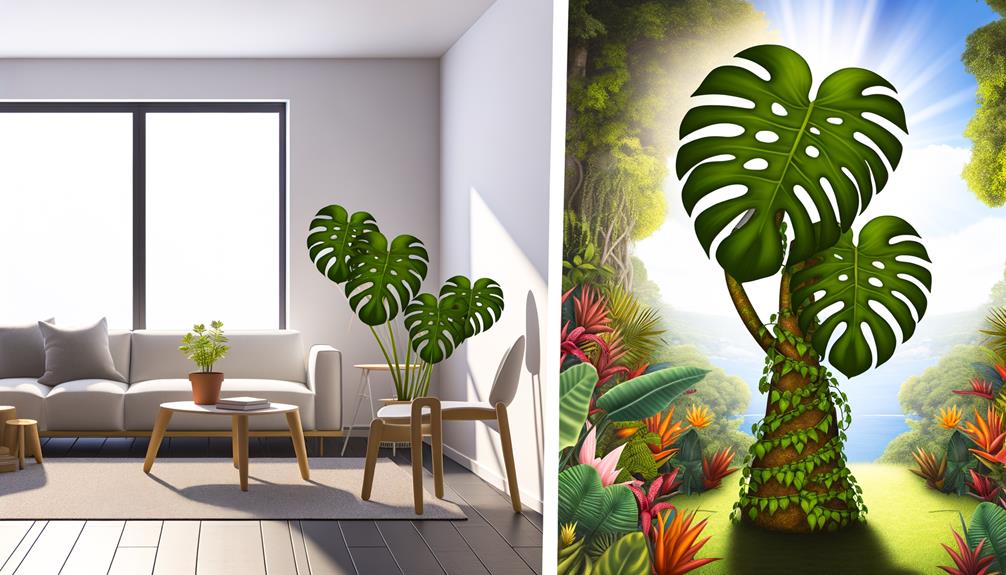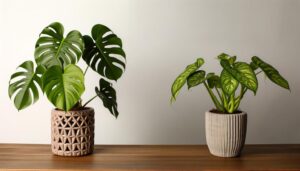Monstera Dubia Indoor Vs Outdoor Care
For Monstera Dubia indoors, place it in bright, indirect light, maintain temperatures between 65-80°F, and keep humidity levels at 60-80%. Water when the top inch of soil is dry and use well-draining, organic-rich soil.
For outdoor care, choose a shaded area with indirect sunlight. Water deeply but let the soil dry out between waterings.
Protect from strong winds and monitor for pests. Always provide support structures like moss poles or trellises for climbing.
Regularly inspect your plants for pests and diseases to guarantee healthy growth. Uncover more tailored care practices to make your Monstera thrive.

Key Takeaways
- Indoor Monstera Dubia needs bright, indirect light and should be kept away from direct sunlight.
- Outdoor Monstera Dubia thrives in shaded spots with indirect sunlight and requires protection from strong winds.
- Indoor plants require well-draining soil and should be watered when the top inch of soil is dry.
- Outdoor Monstera Dubia benefits from deep watering and mulch to retain moisture, allowing soil to dry between waterings.
- Indoor care involves maintaining consistent temperature and monthly fertilization, while outdoor care focuses on pest monitoring and disease prevention.
Light Requirements
When caring for Monstera Dubia, make sure it receives bright, indirect light to mimic its natural rainforest understory habitat. Place it near a north or east-facing window, where it can get filtered sunlight.
Direct sunlight can scorch its leaves, causing chlorosis and reduced photosynthesis efficiency. If growing outdoors, situate it under a tree canopy or a shaded patio. Avoid deep shade, which can stunt its growth and lead to etiolation—where the plant stretches towards the light, becoming leggy and weak.
In low-light conditions, supplement with artificial grow lights, ensuring they emit a full spectrum. Maintain a consistent light source, as fluctuating light levels can stress the plant, hindering its growth and overall health.
Temperature and Humidity
When caring for Monstera Dubia, you'll want to maintain a best temperature range between 65-80°F to guarantee proper growth.
Additionally, this plant thrives in high humidity levels, ideally around 60-80%.
Be cautious of temperature fluctuations, as sudden changes can stress the plant, leading to stunted growth or leaf damage.
Ideal Temperature Range
A Monstera Dubia's ideal temperature range for thriving indoors is between 65°F to 80°F, with a humidity level of 60-80%. You'll want to maintain your indoor environment remains consistent, as sudden temperature fluctuations can stress the plant.
Position your Monstera Dubia away from drafts, air conditioning vents, and heaters to keep stable conditions. Outdoors, this tropical plant prefers similar temperatures but can tolerate slightly higher ranges, up to 85°F, provided humidity levels are adequate.
Shield it from direct sunlight, which can scorch leaves, and protect it from temperatures below 50°F, which may cause damage. By monitoring and adjusting the temperature, you create an optimal habitat for your Monstera Dubia to flourish.
Humidity Requirements
Maintaining ideal moisture levels is equally important as temperature control for the health of your Monstera Dubia. Aim for moisture levels between 60-80%. In an indoor environment, utilize a hygrometer to accurately monitor moisture.
If levels drop below the prime range, employ a humidifier or place a water tray near the plant to increase dampness. For outdoor care, position the plant in a location with natural moisture, avoiding overly dry or windy areas.
Misting the leaves can help boost moisture but should be done sparingly to prevent fungal issues. Consistent moisture supports the plant's physiological processes, promoting vibrant growth and healthy foliage. Adhering to these best practices optimizes your Monstera Dubia thrives in both indoor and outdoor settings.
Temperature Fluctuation Impact
Temperature fluctuations greatly impact Monstera Dubia's health by disrupting its growth patterns and physiological processes. Ideally, maintain a consistent temperature between 65-80°F (18-27°C) to support best growth.
Sudden drops below 50°F (10°C) can cause cellular damage, while excessive heat above 90°F (32°C) can lead to dehydration and stress.
Indoors, use a stable environment to mitigate these fluctuations. Position your plant away from drafts, air conditioners, and heaters. Outdoors, select a location with partial shade to buffer against temperature extremes.
Humidity also plays an important role. Monstera Dubia thrives in 60-80% humidity. Utilize humidifiers indoors or mist the leaves regularly. Outdoors, consider placing the plant near water features to naturally elevate humidity levels.
Watering Needs
When caring for Monstera Dubia, you'll need to adjust your watering schedule based on whether the plant is indoors or outdoors.
Indoors, maintain consistent soil moisture by watering when the top inch of soil is dry, ensuring well-draining soil to prevent root rot.
Outdoors, you'll need to account for natural rainfall and potentially more frequent watering, as outdoor conditions can lead to faster soil evaporation.
Indoor Watering Frequency
To achieve the best development, you should water your indoor Monstera Dubia when the top inch of soil feels dry to the touch. This practice guarantees that the plant receives sufficient hydration while preventing root rot. Use your finger to check the soil moisture level accurately.
Typically, watering once a week is sufficient, but this can vary based on ambient humidity and temperature. It's important to use room-temperature water to avoid shocking the roots. For optimal outcomes, employ a watering can with a narrow spout to direct water evenly around the base. Ensure excess water drains out to prevent waterlogging, which can lead to root decay.
Monitoring and adjusting to your plant's specific environment will promote healthy development.
Outdoor Moisture Requirements
Outdoor Monstera Dubia needs consistent watering to flourish, especially during dry spells, maintaining the soil's even moisture without being waterlogged.
You should water deeply, allowing the moisture to thoroughly penetrate the root zone. This promotes strong root development and prevents surface roots that may dry out rapidly.
Check the soil's moisture level by inserting your finger about an inch deep; if it feels dry, it's time to water. Use mulch to retain soil moisture and decrease evaporation, but make sure it doesn't come in contact with the plant's stem to avoid rot.
Adjust your watering frequency based on weather conditions, increasing during hot, dry periods and decreasing during cooler, wetter seasons. This well-rounded approach ensures the best growth and health for your Monstera Dubia.
Soil and Fertilization
Monstera Dubia thrives in well-draining soil that's rich in organic matter, ensuring top-notch nutrient absorption and root health. For peak growth, use a potting mix that includes peat moss, perlite, and orchid bark. This combination provides the necessary aeration and moisture retention.
During the growing season, fertilize your Monstera Dubia every 4-6 weeks with a balanced, water-soluble fertilizer diluted to half strength.
Consider these top-notch practices:
- Organic compost: Incorporate compost to enhance soil fertility and microbial activity.
- pH balance: Maintain a slightly acidic to neutral pH (6.0-7.0).
- Slow-release fertilizers: Use these for consistent nutrient supply.
- Avoid over-fertilization: Prevent nutrient burn by not exceeding recommended amounts.
These steps will help your Monstera Dubia flourish, whether indoors or outdoors.
Support Structures
Support structures are essential for Monstera Dubia, as they mimic the plant's natural climbing habitat and promote vertical growth. Use moss poles, trellises, or coir poles to provide the necessary support. These structures encourage the development of larger, fenestrated leaves by allowing aerial roots to attach and absorb moisture and nutrients.
Secure the plant gently with soft ties to avoid damaging the stem. Make sure the support structure is stable and anchored well, as a shaky one can hinder growth. Place the structure close to the plant base, guiding the vine upwards. Regularly check and adjust ties to accommodate growth.
This practice ensures peak health and aesthetic appeal for your Monstera Dubia, whether grown indoors or outdoors.
Pest and Disease Management
While proper support structures greatly aid in the growth of Monstera Dubia, attentive pest and disease management maximizes the plant's health and flourishing.
Regularly examine your Monstera Dubia for signs of common pests like spider mites, aphids, and scale insects. Use a magnifying glass to detect these tiny invaders early. Employ organic insecticidal soaps or neem oil treatments to combat infestations effectively. Also, ensure appropriate air circulation and avoid overwatering to prevent fungal diseases.
Best practices include:
- Examining leaves weekly for discoloration or deformation.
- Using organic treatments to avoid chemical damage.
- Maintaining ideal humidity to deter pests.
- Trimming affected areas immediately to prevent spread.
Conclusion
To wrap it up, whether you're nurturing your Monstera dubia indoors or outdoors, understanding its care requirements is essential. Did you know that a well-maintained Monstera dubia can grow up to 6 feet tall?
Make sure it gets medium to bright indirect light, maintains a temperature between 65-80°F, and consistent humidity levels. Regular watering, well-draining soil, and organic fertilizers boost its health.
Don't forget to provide support structures and monitor for pests. Your Monstera dubia will thrive with proper care!






